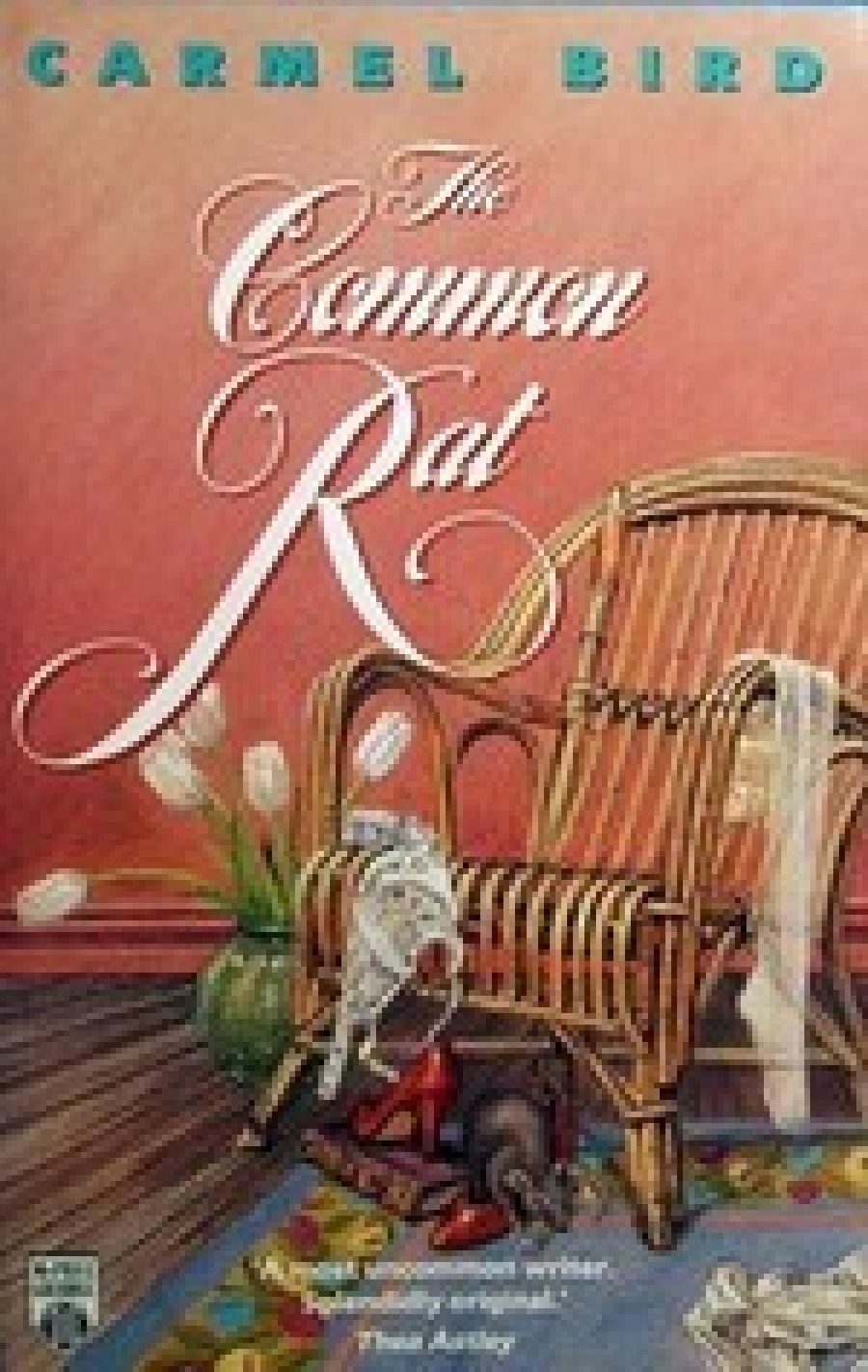
- Free Article: No
- Contents Category: Fiction
- Review Article: Yes
- Online Only: No
- Custom Highlight Text:
There are some pretty ambiguous rats in this collection and most of them are male but ultimately, it’s the writer’s own unease that cumulatively gnaws away at happiness and achievement.
- Book 1 Title: The Common Rat
- Book 1 Biblio: McPhee Gribble, $14.95 pb
Or in ‘I Hear the Chopper Going Over‘:
When the ads came on Diane called out to me to come and look. See that girl advertising skim milk, Diane said, well she’s got a transplant. And guess whose heart it is really? I said I couldn’t guess. It’s my fiancé’s ex-wife’s brother’s heart. I asked her how she knew that and Diane explained that the brother died in a road accident and his heart was flown to the hospital across the road by chopper. The same night the girl with the skim milk got the heart. Must be his, Diane said.
Carmel Bird introduces these twenty-nine stories and essays pointedly with ‘Asking for Trouble‘ – a challenging association of images, bits of imagined and reconstructed conversation, wound into a publishing history of the present volume. They are, she says, ‘a collection of pieces of my writing from the past ten years ... about order and beauty, and about the presence within order of chaotic forces ... beneath the house the cat discovers rats and puts them neatly on the doorstep. I delight in doorsteps, places that mark the threshold between inside and out. And when there is a dead rat on the mat for me I am reminded ... of how close the darkness lies.’
Bird’s stories flicker impressionistically through scenes and characters with confidence and delicacy. The fact that all have been previously published shows that each is able to ‘fight for itself’ in the publishing marketplace.
The introduction is immediately engaging and as well offers a view of the subject of all fiction as ‘some kind of trouble’. Death and disillusion certainly take centre stage in these craftily written pieces. Actual deaths, relationship deaths, and cultural deaths. Fears, dreams, fantasies, dominate. But the final sense is one of equivocation.
I must say the book reads better the second time. At first there’s a lack of power so that many pieces seem bitsy, unfinished – needing to be developed. I kept waiting for some major engagement with the menace or terror of ‘the dark side’ – even if it were Slessor’s disconcerting nihilism rather than Baynton’s gothic nightmare. Bird seems fascinated more with the prospect of calamity than with actually confronting or exploring the horror itself. But the complex artistry grows on you.
‘The Common Rat: A Story in Seven Parts’ begins this new volume. It’s a neat idea –firmly and subtly written – yoking together seven short stories into one ‘frame’. All are cleverly multi-layered and suggestively ambiguous. The first story not only recounts anecdotes in the narrator’s experience of rats but explores implicitly her relationship with Jack (a common rat) against a context of The Pied Piper of Hamelin, The Wind in the Willows, and a psychology tutor’s dictum that ‘The life span of sexual passion between couples is never greater than a period of five years’. It’s a neatly unresolved piece leading to another neatly (but differently) unresolved piece in which Jack (the same) nearly recounts a terrible recurring dream (it’s about children being imprisoned in a silo) to a mate at the Cricketers’ Arms, but is diverted from this (and a conversation about a mutual lover) by the cricket on pub television.
Carmel Bird has an eye for a good opener and every piece begins strongly. She also realises (as in ‘Selling Up’) that some of the power in writing – particularly with shorter forms, both in poetry and prose – comes from suggestion and omission.
And many of the pieces are imbued with an awareness of how the writing process shapes or is implicated by the construction of fiction. Take ‘Pomona Avenue’ for example where the whole story explores alternative ways of ‘telling’ us that ‘mother committed suicide’.
I think Bird is at her very best with what she calls the ‘essays’. Apart from the introduction, there’s ‘Regular Engagement’, a condensed account of her writing classes, and ‘The Red Riding Hood Virus’, about how girls are ‘civilised’ through fairy stories such as Cinderella and Little Red Riding Hood.
This is not a collection that suggests harmony, completion, achievement of some patterned delight but one that shows failure, frustration, disillusion – the fragments of life. These are varied, often vivid, teasing ‘fictions’ that are crafted with finesse and wrestle with their own incompleteness and impossibility (in Jacqueline Rose’s sense).
Using filmic notions of frame and the flickering of images as a structural device, playing with verbal resonance and technique, Bird has assembled an intriguing collection of her writings which will enhance her reputation as a stylish and provocative writer.


Comments powered by CComment